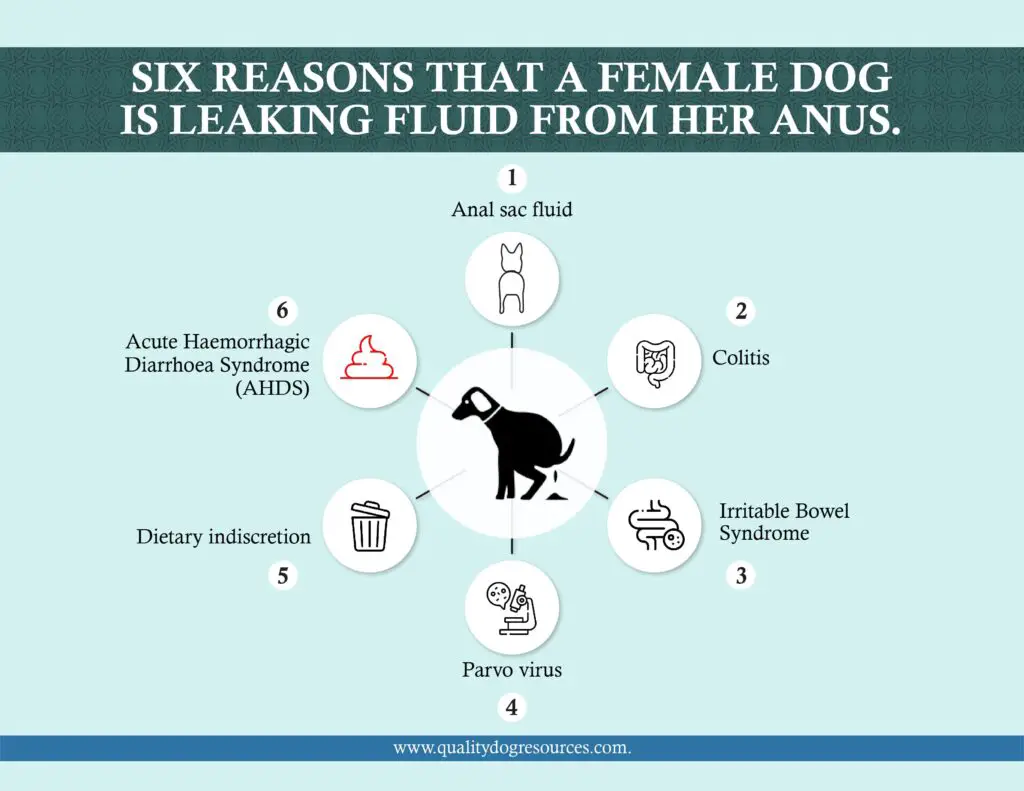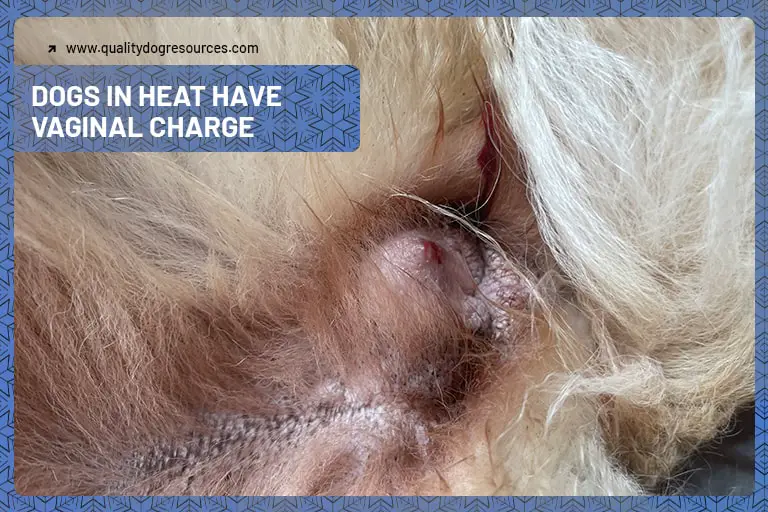
There are six reasons why your female dog is leaking fluid from their anus and there are four common reasons that your bitch might be leaking fluid from her vagina. Sometimes when all you’ve got as evidence is the fluid itself, it is hard to know if it is leaking from their bottom or their vulva.
Although your dog might be leaking a clear fluid, the fluid might also be coloured white or yellow (if it is pus), brown (if it contains stool) or even red (if it contains blood.) And the consistency of the fluid will vary as well- from something that closely resembles water to a substance that has much more of a jelly or mucus texture. The most common reason that your bitch is leaking fluid from her bum is that it is coming from her anal sacs and the most likely reason that they have a vaginal discharge is that they have a urinary tract infection.
Six reasons that a female dog is leaking fluid from their anus

A male or female dog should only have stool coming out of their anus. Even a dog on the best diet will have the occasional bout of diarrhoea but the type of fluids that I have identified below aren’t diarrhoea.
There are 6 reasons that would cause a female dog to leak fluid from their bottom.
- Anal sac fluid
- Colitis
- Irritable Bowel Syndrome (IBS)
- Parvo
- Dietary indiscretion
- Acute Haemorrhagic Diarrhoea Syndrome (AHDS)
Anal sac fluid
Anal sac fluid is a liquid that is discharged every time that a dog passes a bowel movement. The fluid is released through two ducts which are located either side of a dog’s anus. Female and male dogs have anal sacs and release this fluid. The smell of the fluid is unique to every dog. It has a very strong fishy odour to it. The most popular reason that dogs are thought to secrete this fluid is as a way of marking territory. However, other people believe that it’s real function is to help dogs pass hard stools.
When the anal sacs are working correctly the colour of this discharge can vary in colour between clear and brown.
However, if a dog has anal sac disease or impaction (as it is also sometimes called) then you are more likely to see a green or yellow like pus being discharged or you might see some blood mixed in.
Colitis
Colitis is the inflammation of a dog’s colon (large intestine.) One of the main symptoms of colitis is that a dog’s stool is more watery and sometimes you will see spots of blood in their faeces. Sometimes the stool can have the consistency of mucus, not water.
Irritable Bowel Syndrome (IBS)
IBS is a syndrome where the intestine within a dog has become so irritated or inflamed that it can’t digest or absorb nutrients properly. A common symptom of IBS is diarrhea which tends to be very watery and can have some flecks of blood in it.
Parvo
Parvo is a virus that can be caught by dogs of any age but unvaccinated dogs and dogs that are younger than for months. A key symptom of parvo is very severe and persistent diarrhoea which is very watery, brown, foul smelling and may contain specks of blood.
Dietary Indiscretion
This behaviour involves a dog that eats anything outside of its normal diet. It can include eating: faeces from other animals, garbage or even table scraps. A symptom of dietary indiscretion can be severe diarrhea which will be watery.
Acute Haemorrhagic Diarrhoea Syndrome (AHDS)
AHDS occurs when lots of fluid seeps into a dog’s gut. The causes of the disease aren’t known. The most common symptom of this disease is either severe diarrhoea or vomiting. The diarrhoea can at times contain so much blood that it resembles raspberry jam.
Four reasons for vaginal discharge in bitches
Vaginal discharge is the appearance of any liquid substance (except urine) that comes out of the vagina. The discharge can vary in texture and colour. There are four main reasons that a bitch will discharge fluid from her vagina.They are:
- Dog in heat
- Vaginitis
- Pyometra
- Urinary Tract Infection
Dog in heat

A dog in heat is a female dog that has started its reproductive cycle. This cycle lasts about three weeks. The discharge is in many female dogs the most obvious sign that their reproductive or estrous cycle has begun. A few days after the estrous cycle has begun, a bitch starts to discharge blood which over time becomes more watery. The colour of the discharge changes from dark red to a pale pink. Another symptom of a bitch being in heat is that they urinate more.
Vaginitis
Vaginitis literally means inflamed vagina. It can affect spayed or intact females and it can affect dogs of any age or any breed. The most common symptom of vaginitis is discharge, which can be seen in about 9 out of 10 cases. The discharge can vary in texture between water and pus and it can vary in colour between white and yellow.
Pyometra
Pyometra is an infection inside the womb of a female dog. Any intact female dog over six years of age is at risk. Occurring a few weeks after a dog finishes their reproductive cycle, the changes in the hormones can trigger a bacterial infection. As a result the womb fills with pus.
Pyometra appears in one of two forms- open or closed. In open pyometra (where the dog’s cervix remains open) the pus can leak out of the vagina and the pus may be seen on their coat or in places where they have been sleeping, such as their bed. In closed pyometra where the dog’s cervix remains closed) the pub can’t leak out through the vagina and instead it collects in the uterus and causes a distended abdomen.
Urinary Tract Infection (UTI)
A UTI can be caused by a number of different factors. The urinary tract includes the kidneys, bladder, ureters (the tubes that connect the kidneys to the bladder) and the urethra (the tube through which urine comes out of the body.) A UTI might be caused by a bacteria such as E. coli or by a fungus. Any dog no matter what sex, age or breed can get a UTI. One symptom of this infection is that dogs might drip urine which might contain some blood.






